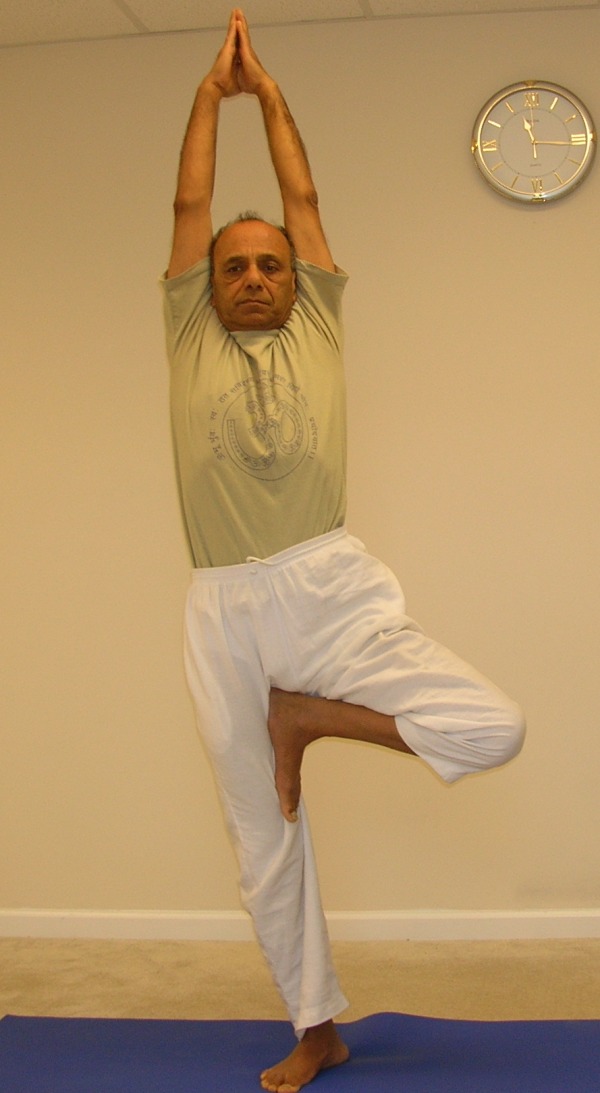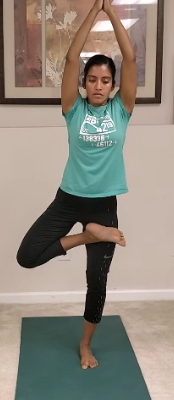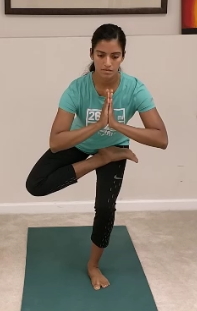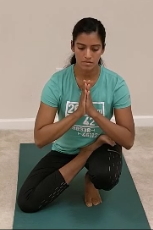
Vrikshasana (tree pose)
The Tree Pose (Vrikshasana) (वृक्षासन) is one of the most commonly practiced one-leg balancing poses. In its final position, the Tree pose represents the grace and stability of a tall tree. Here are some of the benefits that are common to all one-leg balancing poses.
- Develop better coordination and harmony between different parts of the body
- Develop a sense of calm, mental stability and patience
- Provides a good stretch for the groin, thighs, knees, shoulders and the chest
- Remove stress and nervousness and bring about a state of mental equanimity
- Since one of the legs is doing the work of two legs in supporting the weight of the body, this supporting leg gets strengthened.
- Develop not just physical balance, but also a deep sense of mental focus and concentration; remember, if the mind wanders, you lose balance; if the eyes wander, you lose balance.
- Helps with sciatica
The Tree Pose (Vrikshasana) is a relatively simple pose to practice and yet provides all the benefits of the one-leg balancing poses mentioned above.
My friend, Maanasa Sunkara, has graciously agreed to feature in this video to demonstrate the Vrikshasana and its variations. I hope you will enjoy practicing with the video.
Step-by-Step
- Come to a standing position on your mat with your feet about hip distance apart, body tall and straight, and the arms hanging comfortably alongside the body.
- From the standing pose, lift the right foot up, shifting all the weight onto the left leg. Turn the right knee all the way to the right resting the sole of the foot against the left thigh.
- Fix your gaze at some point in front of you, on the floor or the wall in front. Slowly slide the right foot up the left leg, trying to bring it up to the top of the thigh. If you can’t bring the foot all the way up, place it on the leg wherever you feel comfortable. If you need to, keep the foot against the leg below the knee. Avoid putting the foot against the knee.
- When you feel that you are balanced here, slowly bring the palms together in the prayer position in front of the heart. Take a couple of deep breaths here.
- Keep gazing at your focal point in front. Keep the left leg strong pressing the foot flat into the floor. Try to maintain the right knee bent at 90 degrees towards the right side. The shoulders are relaxed and rolled back and the chest is pressing forward.
- If you feel balanced here, try the next stage by raising the arms vertical over the head. Join the palms together with the thumbs crossed, stretch the elbows straight and pull the arms upward..
- Hold the position for 6-8 breaths, if comfortable.
- To come out of the pose, slowly exhale the arms down and then release the legs back into a standing position.
- Repeat the above steps on the other side.
Variation 1: Padma-vrikshasana (Half-lotus Variation)

Padma-vrikshasana
- In this variation, instead of placing the sole of the foot against the thigh, place the foot on top of the opposite thigh in the half-lotus position. Try to keep the foot as high up the thigh as comfortable.
- Try to lower the bent knee as far as you can.
- Follow the rest of the instructions as above for the regular tree pose.
Modifications
- If you have trouble maintaining balance, you may take the support of the wall.
- When balancing on the left leg, turn sideways alongside the wall, with the right knee gently touching the wall. It is the knee that will provide you support for balance.
- When balancing on the right leg, turn around and use the left knee against the wall for support.
- As you become more comfortable in the position, you may attempt to move the knee away from the wall and try to maintain balance.
Variation 2: Padma-vrikshasana to Tip-toe balance
- Start in the Padma-vrikshasana, as described above, keeping the right foot on top of the left thigh. Keep the palms in the prayer position against the chest.
- Slowly, begin to bend the left knee, coming into the Utkatasana (half-chair pose). Try to keep the torso upright. Stay in this position for 3-4 breaths.
- Bending slightly forward, place the palms on the floor and then slowly release the buttocks down toward the floor, coming into the tip-toe pose (Padangushthasana). Keep the palms on the floor to help with balance.
- Here, if you feel comfortable, try to bring the right knee all the way down to the floor. If not, keep the knee up and maintain the position for 5-6 breaths.
- If you can bring the knee to the floor, you can attempt the full balance by bringing the palms in the prayer position in front of the chest. You may find this balance somewhat challenging in the beginning. Maintain the position for 5-6 breaths.
- To come back up, press the palms into the floor and begin to come back up slowly, and try to get back to the utkatasana (half-chair) as before. Pause there for an extra breath and finally come back up all the way and then release the hands and the leg down.
- Relax for a few breaths and repeat the above steps on the other side.

Padma-utkatasana

Padangushthasana (tip-toe)
Recent Comments